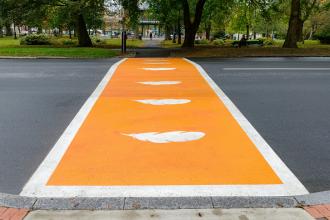Delivering respectful, safe health care to Indigenous people in BC
“The enjoyment of the highest attainable standard of health is one of the fundamental rights of every human being without distinction of race, religion, political belief, economic or social condition.”
—World Health Organization
The Joint Collaborative Committees (JCCs) acknowledge that they must be learners and active participants in decolonizing BC’s health care system, returning the right to access quality health care that is safe and free of racism and discrimination to Indigenous peoples (First Nations, Métis, and Inuit).
Further to the release of the 2020 In Plain Sight report, the JCCs have prioritized partnering with Indigenous communities and health care organizations to respond to the needs of Indigenous patients and be inclusive of Indigenous perspectives of health and wellness.
The JCCs are advancing cultural safety by positioning health care professionals as humble and respectful partners in care with patients[1] in Indigenous cultural experiences, feelings, and beliefs. As a start, the JCCs, with divisions of family practice and facility-based medical staff associations, are:
- Enhancing physicians’ knowledge of cultural safety and humility through learning series and training.
- Advancing Indigenous people’s representation on its committees.
- Providing funding to recognize the time invested and contributions made by Indigenous people at JCC-initiated meetings and events.
- Supporting partnerships and quality improvement initiatives with Indigenous communities and the integration of cultural advisors, traditional wellness healers, and Elders through primary care networks.
- Developing linkages to local Indigenous communities and people and ensuring good relationships between physicians and Indigenous leadership.
Across facilities and communities in BC, doctors are also leading initiatives and projects through the JCCs that embed culturally safe care into practice. Here are a few examples.
Cultural and community connections
In Tofino, an emergency room and family medicine doctor saw how traditional practices helped a group of patients who were struggling with trauma and experiencing substance use that required frequent treatment in hospital. Wanting to learn more and understand better, the physician collaborated with a Tla-o-qui-aht First Nation healer and a cultural worker to introduce a group of local health care professionals to traditional healing practices.
They arranged a cultural ceremony that included Tla-o-qui-aht First Nation members, physicians, nurses, X-ray and laboratory technicians, and a firefighter. It incorporated a talking circle, breathing exercises, drumming and singing, and cold-water cleansing pools. Together they explored how these practices and stronger cultural connections might blend with medical care to support people who experience trauma and pain, as well as the benefits of making traditional, nonmedical interventions more available to health professionals. Read more at https://facilityengagement.ca/cultural-connections-collaboration.
Holistic healing
Gathering as a community and learning from Elders are important means for community engagement for Indigenous people. Through a JCC initiative, a traditional gathering in Williams Lake brought together Secwépemc Elders to talk about medication use in their community, where a holistic approach to health and wellness was once the norm.
Understanding that storytelling is the traditional way for Indigenous communities to share knowledge, wisdom, and humor, a story titled Coyote’s Food Medicines was developed to connect with communities about medications. The award-nominated book was created in partnership between the JCCs, the First Nations Health Authority (FNHA), and the Interior Health Authority, with guidance from Elders, illustrations by Georgia Lesley, and design and production by Drawing Wisdom. Through a beautifully stitched narrative, the story opens a safe space for Indigenous people to discuss the importance of maintaining good health when taking multiple prescribed medications, while encouraging meaningful conversations with health care providers. Read the full story at www.coyotestory.ca.
Access to quality care closer to home
Indigenous populations in rural BC communities face significant barriers to accessing quality care, including having to travel long distances to and from appointments, a lack of providers and services in rural communities, and a lack of access to culturally safe care. These hurdles were further emphasized with the start of the COVID-19 pandemic. In April 2020, the First Nations Virtual Doctor of the Day program was launched by the FNHA and the Rural Coordination Centre of BC (RCCbc), which is funded by the JCCs. The program is one of three Real-Time Virtual Support pathways offered by the RCCbc to enhance health equity in BC rural, remote, and Indigenous communities.
Operating 7 days a week, the program enables Indigenous people who have limited or no access to a doctor to receive culturally safe primary care virtually; it also supports community-based nurses and other health professionals to deliver primary care. In the program’s first year, there were more than 6000 encounters between doctors and hundreds of patients who accessed the service. All physicians have training or experience in cultural safety and humility, and many of the doctors have Indigenous ancestry. Access the service and learn more at www.fnha.ca/what-we-do/ehealth/virtual-doctor-of-the-day.
The JCCs commit to keeping the conversation going with and between Indigenous communities and BC doctors, as well as collaborating with health care partners to develop solutions that address systemic health equity issues. Learn more about the JCCs at www.collaborateonhealthbc.ca.
—Ahmer A. Karimuddin, MD, FRCSC
Co-chair, Specialist Services Committee
—Jiwei Li, MD
Co-chair, Shared Care Committee
hidden
This article is the opinion of the Joint Collaborative Committees (JCCs) and has not been peer reviewed by the BCMJ Editorial Board.
 |
| This work is licensed under a Creative Commons Attribution-NonCommercial-NoDerivatives 4.0 International License. |
References
1. First Nations Health Authority. FNHA’s policy statement on cultural safety and humility. Accessed 14 March 2022. www.fnha.ca/Documents/FNHA-Policy-Statement-Cultural-Safety-and-Humility.pdf.

